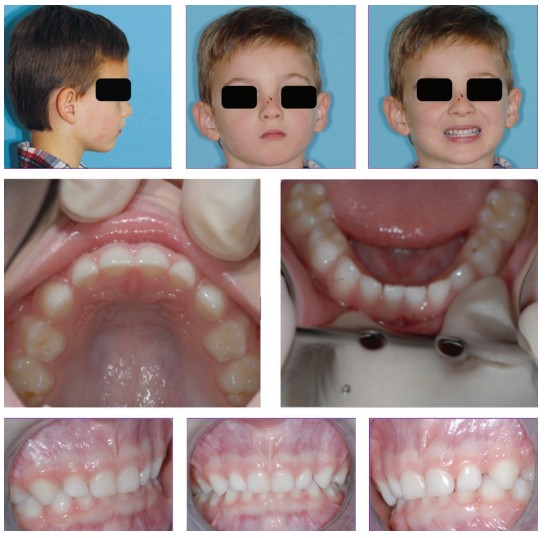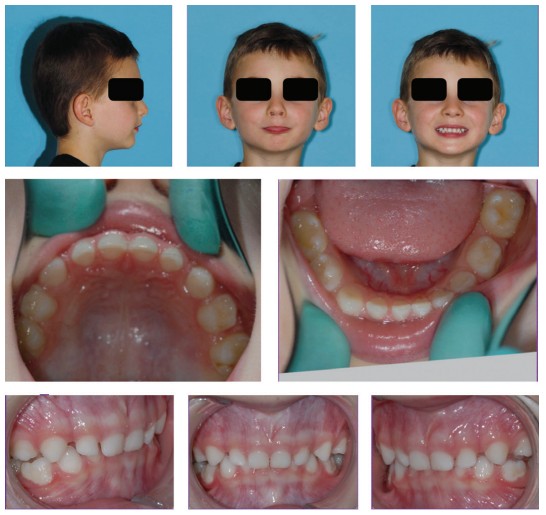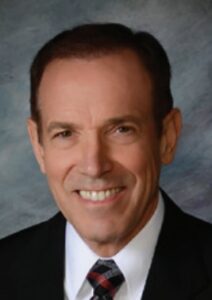CEU (Continuing Education Unit): 2 Credits
Educational aims and objectives
This self-instructional course for dentists and orthodontists aims to discuss the pivotal role that orthodontists can take in the healthcare of very young children with airway issues.
Expected outcomes
Orthodontic Practice US subscribers can answer the CE questions by taking the quiz online to earn 2 hours of CE from reading this article. Correctly answering the questions will demonstrate the reader can:
- Realize the effect that sleep-disordered breathing has in brain growth in young children.
- Review some history regarding treating children in the primary dentition for sleep-breathing
- Recognize the importance of facilitating nasal breathing in children.
- Observe a case study of a young patient who was treated at a young age for sleep-breathing disorders.

Dr. William M. Hang discusses orthodontists’ logical leading role as healthcare providers for very young children with airway problems
Introduction
The 2017 ADA directive for dentists to screen for sleep/breathing problems1 opened the door for a completely new era in dentistry. With this new focus, the orthodontic profession logically becomes the best-positioned group to assume a pivotal role in treating patients with airway issues. A quick scan of the program for the recent American Association of Orthodontists meeting in Miami, however, revealed only 5 of 237 scheduled lectures mentioned “airway” in the title. Does this indicate there is little interest in treating airway issues? None of the “airway” lectures seemed to focus on treating very young children. Is there really a need for treating very young children for airway problems?
Dr. Ronald Harper, PhD and neurobiologist at UCLA, has documented areas of the brain that are damaged with even one night of reduced oxygen saturation secondary to sleep/breathing issues in very young children.2 Dr. Philip Cooper Jr. has drawn particular attention to the African American children with his book, Why? African American Children Can Not Read.3 His premise is that many have sustained brain damage very early in their lives as a result of breathing-disordered sleep, including OSA. Dr. Cooper makes a strong case that many may never overcome this damage to lead normal lives.
Dr. John Remmers, a Harvard-trained early pioneer in the sleep arena, states that OSA wouldn’t exist if our jaws were forward like our ancestors.4 Anthropologists Daniel Lieberman and Robert Corrucinni have described the reasons our jaws have failed to grow forward like our ancestors.5,6
Dr. Christian Guilleminault (1938-2019) was the former head of the sleep clinic at Stanford University and arguably the most-published person in the medical sleep arena. He lectured at the January 2019 American Association of Orthodontists (AAO) meeting on airway. Dr. Guilleminault noted that children experience the frequent occurrence of sleep/breathing problems long before they erupt any permanent teeth. He further described significant health problems these children will encounter throughout their lives unless something is done. Dr. Guilleminault made a very strong call for treatment as soon as any problem is recognized. He stated that establishing 100% nasal breathing at the earliest age possible was critical for optimizing dentofacial growth and future health.7
A 2020 Journal of Clinical Orthodontic (JCO) survey shows the responding orthodontists recommended age 7 for a first orthodontic exam as per the AAO guidelines. Eleven years old, however, was the recommended age to begin treatment.8 How much brain damage and other serious health issues are we willing to tolerate for our kids if we continue to wait for permanent teeth to erupt? Could/should orthodontists be treating some children in the primary dentition?
After combining the ideas of all the preceding experts on airway and facial development, it becomes clear that we need to do everything possible to develop faces forward and treat as early as possible.
Treating children in the primary dentition is not a new idea. Over 100 years ago, articles appeared about breathing disorders affecting very young children and how the profession must treat these problems very early. In 1912, Bogue recommended treatment to widen the dental arches prior to age six. Citing the serious health issues that were occurring, he focused less on teeth and more on health aspects of getting all children to be nasal breathers.9 Cohen stated in 1922, “Treating the dental deformity before the sixth year insures not only good mouth functioning but also correct breathing, since the width of the maxillary arch determines whether or not there is room for normal nasal breathing.”10 As recently as 1931, L. De Coster recommended beginning treatment as young as 3 years of age.11
All these authors were concerned about establishing nasal breathing patterns and focused secondarily on teeth. Strong calls for very early intervention with a focus on establishing nasal breathing by these early pioneers lost out to louder voices in the profession who focused on a mechanistic approach of aligning teeth in the permanent dentition. This is the current paradigm. Few articles in orthodontic journals today make a compelling case that establishing nasal breathing should be part of every orthodontic treatment plan.
For more than 50 years, John Mew has theorized that all malocclusions are caused by poor rest oral posture. He makes the point that for most people, both jaws are significantly recessed from where they should be. Mew points out that our ancestor’s jaws were much farther forward.12 His ideas correlate well with Lieberman and Corruccini. More importantly, he has developed a protocol and advocated for treatment to develop both jaws forward in young growing children under age 10. In 2000, I noticed substantial airway improvements in patients I had treated with this protocol. In 2007, Singh, Garcia-Motta, and Hang published an article showing dramatic airway improvements in patients treated with this protocol. This research found a 31% increase in the airway at the dorsum of the palate, 23% increase at the base of the tongue, and 9% increase in the laryngopharyngeal area.13 We never promise any patients that we can or will improve their airway. Having said that, optimizing airway has been the primary goal in our practice for several decades.
Mew’s protocol had traditionally been reserved for treating patients in the mixed dentition when all four upper incisors were in the mouth. After witnessing several patients in the primary dentition having unfavorable vertical growth with both jaws falling back substantially from the primary dentition until the permanent incisors were in place, I decided I had to begin treating patients in the primary dentition. We began doing this nearly 2 decades ago and are still in a discovery mode refining our protocol.
The effectiveness of this protocol in eliminating OSA in a very young child was demonstrated 12 years ago when we treated a 5-year 2-month-old boy who had been diagnosed with Pierre Robin Sequence, OSA, and Failure to Thrive. Prior to eruption of any permanent teeth, we advanced the maxillary anterior teeth substantially while at the same time expanding laterally according to our adaptation of Mew’s protocol. The patient then cooperated well with a postural appliance, and the mandible came forward, opening the airway. Dr. Stephen Sheldon, director of the Sleep Medicine Center of Lurie Children’s Hospital of Chicago, reported that the patient had a sleep study indicating his OSA was completely eliminated. This case was later published by Dr. Sheldon14 (Figure 1). Subsequent follow-up with the family has found this boy has grown normally, is excelling in school, and is an aggressive tennis player at age 17. Clearly, he is one of the lucky ones whose problem was resolved before he sustained brain damage, which might have affected his academic performance, motor coordination, and overall health.
The mantra of the dental/orthodontic profession in response to the OSA issue is to expand laterally. My experience confirms that lateral expansion alone is frequently not going to resolve a serious sleep/breathing issue. In response to a lecture emphasizing lateral expansion about 5 years ago, I stated, “You can’t expand your way out of an anteroposterior problem.” As noted earlier, John Remmers, MD, indicates OSA is an anteroposterior issue.4 Guilliminault and Quo confirm that lateral expansion may not be enough to resolve breathing/sleep issues.15

After combining the ideas of all the preceding experts on airway and facial development, it becomes clear that we need to do everything possible to develop faces forward and treat as early as possible.
Case study
The patient in Figure 2 case illustrates this. The boy was 3 years 11 months old when we first examined him. His mother reported that at age 2 he was tired all the time. She described him as “looking sickly with bags under his eyes.” She also reported a sleep test administered somewhere between age 2 to 2 ½ revealed “… acute/severe OSA with oxygen desaturation to 93%.” Even after T&A (ENT reported tonsils as “humongous”), he remained a restless sleeper, still appeared tired, etc. His mother wanted to see what might be done to improve his airway/sleep.

Minimal spacing of the anterior primary teeth and a CBCT showing very large permanent incisors suggested lateral expansion of both arches would be a good first step in treating him. Many may be afraid of expanding the lower arch given the fact that there is no midline suture. They were not taught in their ortho training that lower expansion was possible. Others may be afraid that the first molars being unerupted will not expand and may require later expansion. We’ve been expanding lower arches in growing children in the mixed dentition for almost 40 years and have done so for my own boys (now 46 and 44, respectively) and one grandson who is now 13 and will never need to wear braces.
We placed a removable upper expander with an 11-mm screw, and about 2 weeks later added a fixed lower expander with an 11-mm screw cemented on the lower primary second molars. These were activated ¼ mm every 4 days. This rate is very physiologic and is easily tolerated by most children. At this rate, 10 mm of lateral expansion can be achieved in as little as 5 months (Figure 3). Orthodontists are all familiar with documented improvements in the nasal airway with maxillary expansion. These airway improvements in the nasal passages are all a plus in reducing resistance to airflow. Having acknowledged that, the collapse of an airway producing apneic events typically occurs with either the soft palate or the tongue (or both) falling back to occlude the airway. This is why the A-P plane of space must be part of the solution in many if not most cases. Our emphasis on the structural aspects of this problem does not ignore the reality that poor muscle tonicity of the muscles around the pharynx can also be a contributing factor. That is a separate subject addressed by my colleagues in myofunctional therapy.

Our patient had some improvement in his sleep, and his mother reported that he was now sleeping with his lips together, which had not been the case prior to the lateral expansion. She felt that his sleep was better, but not even close to what she wanted for him. We had originally suggested that Orthotropics® to develop both jaws forward would probably need to follow the “arch development” (10 mm of upper and lower lateral expansion). His parents strongly supported developing both jaws forward, and that treatment is ongoing at this time. Will he respond with a favorable outcome as the previous patient mentioned? There are no promises, but doing nothing is no longer an option for me when I know the negative health consequences of ignoring an obvious sleep/breathing problem. I’d rather try and fail than ignore an obvious problem.
Many in the profession will view this type of treatment with horror since they were taught that advancing teeth will cause recession and possible tooth loss. Anyone concluding that will be ignoring seven articles in the refereed literature reporting this will not occur.16-22 With my own near 40-year experience advancing teeth in the permanent, mixed, and primary dentition, I have not found the drawbacks I had been warned about in my orthodontic residency.
We are in our infancy for understanding these issues. We sorely need more research and innovation to develop approaches, which might be more effective than the approaches that have been developed so far. Research to develop such protocols will never come unless there is a general awareness of the airway (and facial esthetics) and commitment from our profession to find solutions.
Articles on the future of the orthodontic profession abound. Indeed the recent AAO meeting addressed that very subject. COVID-19 has given a great boost to companies marketing aligners directly to the public, and the profession is opposing this trend. Some in the profession have admitted that there is little science to show long-term health benefits of traditional orthodontic care and suggested approaches to compete with direct-to-consumer orthodontics.23 I view these efforts to be futile in the long run. Student debt of those coming out of orthodontic residencies is reported to be above $420K. Many new graduates are struggling to survive. I’ve had a number of people report Internet discussions by young orthodontists wondering if they should have bothered specializing. Might there be a solution to this obvious problem that would open the door for a much brighter future for orthodontists?
The ADA has opened the door for the orthodontic profession to transition into an actual health care profession focusing on airway with the potential to improve the health of our very young children. As noted earlier, the late Dr. Christian Guilleminault and other sleep physicians have carefully described the serious health issues at stake for our kids and called for us to act. No one has all the answers as to how this might play out. Will the profession accept this invitation to refocus the goals of our treatment toward improving the airway in growing children, or will it continue to focus on making teeth straight for adolescents? Will another group, like the pediatric dental profession, step up to the plate to assume this responsibility if the orthodontic profession doesn’t?
From my perspective, orthodontists have been given an engraved invitation to assume leadership, but we’ve not even opened the envelope to see what is inside. The future health of our children (and of the orthodontic profession) depends on us opening that envelope and deciding to act. I believe we were at a crossroads over 100 years ago when orthodontists were more concerned about overall health and treated early with a focus on establishing proper rest oral posture. The profession took the other road, which was treating symptoms (crooked teeth) and waiting until all the permanent teeth were erupted. Looking critically at the health issues facing our children, we now have the opportunity to make a different choice — to treat early, refocus the goal from the teeth to the patient’s overall health, and lead the way in making dentistry the literal center of healthcare. Will we do that? The profession and our patients will prosper if we do. Do we have the collective courage to make this choice? Time will tell.
Dr. Steven Olmos’ article discusses the need for orthodontics for young children as he strives to identify sleep-breathing disorder symptoms in children and adolescents. Read “Pediatric severe apnea/obesity/TMD/headache — Class III” here: https://orthopracticeus.com/pediatric-severe-apneaobesitytmdheadache-class-iii/.
References
- ADA House of Delegates; The Role of Dentistry in the Treatment of Sleep Related Breathing Disorders. Adopted by ADA’s 2017 House of Delegates; 2017.
- Harper RM, Kumar R, Ogren JA, Macey PM: Sleep-disordered breathing: effects on brain structure and function. Respir Physiol Neurobiol. 2013;188(3):383-391.
- Cooper PW Jr. Why?: African American children cannot read. iUniverse; 2009.
- Remmers J. Personal Communication. Scottsdale, AZ.
- Lieberman DE. The evolution of the human head. Harvard University Press. 2011.
- Corruccini RS. How anthropology informs the orthodontic diagnosis of malocclusion’s causes. Edwin Mellen Pr; 1st ed; 1999.
- Guilleminault C Personal Observation, American Association of Orthodontists. Marco Island, FL.
- Keim RG, Vogels III DS, Vogels PB. J Clin Orthod. 2020;54(10):581-610.
- Bogue EA, Orthodontia on the deciduous teeth. The Dental Digest. 1912; n* 10, 11, 12.
- Cohen SA. Malocclusion and its far-reaching effects. 1922;79(23):1895-1897.
- Philippe J. Who introduced early treatment to orthodontics?. Journal of Dentofacial Anomalies and Orthodontics. 2012;15(1):107.
- Mew J. The cause and cure of malocclusion. Published by John Mew, Braylsham Castle, Broad Oak, Heathfield. United Kingdom .
- Singh GD, Garcia-Motta AV, Hang WM. Evaluation of the posterior airway space following biobloc therapy: geometric morphometrics. 2007:25(2):84-9.
- Sheldon SH, Kryger MH, Gozal D, Ferber R. Principles and practice of pediatric sleep medicine, 2nd ed. Elsevier Saunders; 2014.
- Quo SD, Hyunh N, Guilleminault C. Bimaxillary expansion therapy for pediatric sleep-disordered breathing. Sleep Med. 2017;30:45-51.
- Melsen B, Allais D. Factors of importance in development of dehiscences during labial movement of manciular incisors: A retrospective study of adult orthodontic patients. Am J Orthod Dentofacial Orthop. 2005;127:552-61.
- Artun J, Grobety D. Periodontal status of mandibular incisors after orthodontic advancement. Am J Orthod Dentofacial Orthop. 2001;119(1).
- Aziz T, Flores-Mir C, A systematic review of the association between appliance -induced labial movement of mandibular incisors and gingival recession. Aust Orthod J. 2011;(1):33-39.
- Kasha A Gingival recession and labial movement of lower incisors. Evil Based Dent. 2013;14(1):21-2.
- Renkema AM, Navratilova Z, Mazurova K, et al. Gingival labial recessions and the post-treatment proclination of mandibular incisors. Eur J Orthod. 2015;37(5):508-513.
- Ruf S, Hanse K, Panthers H Does orthodontic proclination of lower incisors in children and adolescents cause gingival recession? Am J Orthod Dentofacial Ortho. 1998;114(1):100-106.
- Morris JW, Campbell PM, Tadlock LP, et al. Prevalence of gingival recession after orthodontic tooth movements. Am J Orthod Dentofacial Ortho. 2017;151(5):851-859.
- Ackerman M, Burris B. The way it was, the way it ought to be, the way it is, and the way it will be. Am J Orthod Dentofacial Orthop. 2018;13(2):165-166.
Stay Relevant With Orthodontic Practice US
Join our email list for CE courses and webinars, articles and mores

 William M. Hang, DDS, MSD, graduated at the top of his class from the University of Illinois College of Dentistry and the University of Minnesota Orthodontic program where he briefly taught orthodontics. He has been in private practice since 1975 and is currently practicing in Agoura Hills, California. Having been traditionally trained, he extracted teeth for crowding and often retracted the teeth. For the past 40 years, however, he has been a pioneer in nonretractive treatments to improve the airway in patients of all ages. He received a Lifetime Achievement Award from the American Academy of Physiological Medicine and Dentistry for his work.
William M. Hang, DDS, MSD, graduated at the top of his class from the University of Illinois College of Dentistry and the University of Minnesota Orthodontic program where he briefly taught orthodontics. He has been in private practice since 1975 and is currently practicing in Agoura Hills, California. Having been traditionally trained, he extracted teeth for crowding and often retracted the teeth. For the past 40 years, however, he has been a pioneer in nonretractive treatments to improve the airway in patients of all ages. He received a Lifetime Achievement Award from the American Academy of Physiological Medicine and Dentistry for his work.
